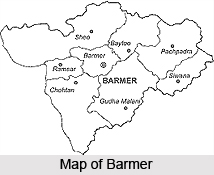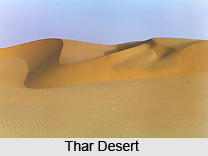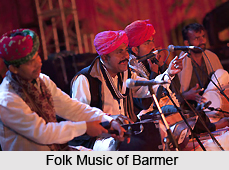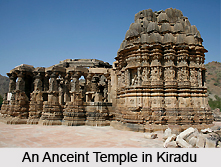 Barmer is described as "Vestibule of the Rajasthani Culture". Barmer is a miniature Rajasthan with all its colour, warmth and tradition. The place is renowned for its intricate embroidery work, multi - hued traditional costumes and block printing of textiles, Barmer is a shopper`s paradise. The city is also famous for carved wood furniture.
Barmer is described as "Vestibule of the Rajasthani Culture". Barmer is a miniature Rajasthan with all its colour, warmth and tradition. The place is renowned for its intricate embroidery work, multi - hued traditional costumes and block printing of textiles, Barmer is a shopper`s paradise. The city is also famous for carved wood furniture.
Origin of name of Barmer
The name Barmer is derived from the ruler Bahada Rao or Bar Rao who is said to have founded the town in the 13th century. Initially called `Bahada-mer` it was later shortened to Barmer.
History of Barmer
According to history, Bhahada Rao or Bar Rao founded the city in 13th century and named the city as Barmer, which means the hill fort of Bar. Barmer is known as a `miniature Rajasthan` In 12th century A.D, the city was known as Mallani.
The present Barmer district was formed in 1949 upon the merger of Jodhpur state in the United States of Great Rajasthan, which is a cluster of ancient paraganas as Mallani Shiv, Pachpadra, Siwana and the Chohatan area. Although the place is barren and has a harsh climate and rough terrain, Barmer is known for its rich crafts, dances and music.
During the Medieval Age, many important kingdoms flourished at various times in Balmer. The chief rulers of Barmer at the time were Khed, Kiradu, Pachpadra, Jasol, Tilwara, Sheo, Balotara and Mallani. In 1212AD Rao Siha, the founder of the Rathore clan, conquered Khed in Barmer district and hoisted the Rathore flag in the area.
In 1836, the district was annexed by the British and a superintendent thenceforth governed the town.
 Geography of Barmer
Geography of Barmer
Barmer is situated in Rajasthan, India. It is part of the Great Indian Desert or Thar Desert. Barmer is situated at a distance of 224km from Jodhpur on the Luni-Munabao section of the Northern Railways. The place is situated on top of a hill; it houses the remains of an old fort called Garh right on its peak. To the west of the city lie the remains of Juna or Juna Barmer and to the south are the ruins of three Jain temples.
Culture of Barmer
Barmer is known for its folk music and dance. There are priest singers at Barmer that compose music in honor of the deities and war heroes. The folk musicians of the place belongs to a community called the Muslim Dholis (drummers). To most of the people of Barmer, this is their means of livelihood. During the festivals and other social occasions, people sing many songs to the accompaniment of the Kamayacha (a stringed instrument played with a bow). The other musical instrument popular in Barmer is the algoza (two flutes played together).
The town of Barmer is the center for woodcarving, pottery, carpets, intricate embroidery work, block printed fabrics and multi-hued traditional costumes.
The people of Barmer live in mud-walled houses that are decorated with delicate folk motifs. The people are found of wearing colorful attires.
 The major fairs and festivals celebrated in Barmer are:
Barmer Festival which is held in March is a time for merry making and enjoyment for the people. During the time, the town is at its colorful best. Another festival celebrated here is the cattle fair that is held every year at Tilwara village situated on the banks of the Luni river. The fair goes on for a fortnight in the months of March April. A major yearly religious fair is held at Khed on every Poornima (full moon) at the Ranchor Rai Mandir there. Another fair is held at a village called Nagar Meva, which is about 8km from the town of Balotara. There is a Jain temple there dedicated to the Jain prophet Parasvanath, and the fair is held every year on Posh Badi (Dec-Jan) to celebrate his birth. Other festivals celebrated at Barmer are Nakoda Parasvanath, Veeratar Mela, Khed Fair and Mallinath Fair.
The major fairs and festivals celebrated in Barmer are:
Barmer Festival which is held in March is a time for merry making and enjoyment for the people. During the time, the town is at its colorful best. Another festival celebrated here is the cattle fair that is held every year at Tilwara village situated on the banks of the Luni river. The fair goes on for a fortnight in the months of March April. A major yearly religious fair is held at Khed on every Poornima (full moon) at the Ranchor Rai Mandir there. Another fair is held at a village called Nagar Meva, which is about 8km from the town of Balotara. There is a Jain temple there dedicated to the Jain prophet Parasvanath, and the fair is held every year on Posh Badi (Dec-Jan) to celebrate his birth. Other festivals celebrated at Barmer are Nakoda Parasvanath, Veeratar Mela, Khed Fair and Mallinath Fair.
Education of Barmer
There are 7065 schools at Barmer. Out of which 6824 schools are for boys and 211 for girls.
Economy of Barmer
Barmer is known all over the world for its production of guar seeds. The most suitable climatic conditions and soil of the region for the cultivation of Guar seeds play major key role in producing superb quality guar seeds. Because of the availability of best quality guar seeds, best quality guargum split (raw material for production of guargum) is produced here. A substantial portion of Indian export of guar gum is sourced from Barmer. About 80% of Guar Gum of world is produced in Rajasthan.
 Barmer is treasure trove of vibrantly coloured embroidery with excellent mirror work. Also famous are beautifully embroidered fabrics and pouches often patterned with tiny mirrors. Traditional rugs, blankets, shawls, carpets, "Pattius" Dari in typical Barmer colors and weave are specialty of the district. The shopping spots include the tiny shops along the narrow lanes of the colorful and lively Sadar Bazar.
Barmer is treasure trove of vibrantly coloured embroidery with excellent mirror work. Also famous are beautifully embroidered fabrics and pouches often patterned with tiny mirrors. Traditional rugs, blankets, shawls, carpets, "Pattius" Dari in typical Barmer colors and weave are specialty of the district. The shopping spots include the tiny shops along the narrow lanes of the colorful and lively Sadar Bazar.
Places of interest in Barmer
Places of interest in Barmer are:
Barmer the town has ruins of an old fort. There are temples dedicated to Balark (the Sun) and the ancient ruins of Juna Barmer. The are also three Jain temples.
Kiradu houses the ruins of five ancient temples - once dedicated to Lord Vishnu and other four dedicated to Lord Shiva.
Khed
Meva Nagar houses three Jain temples and a Vishnu temple.
Balotra is an important center of printing and dying.
Junagarh Fort
Juna Jain temple
Chintamani Parasnath Jain Temple.
Bhand Sagar Temple
Shiv Bari Temple
Camel Breeding Farm
Devi Kund
Gajner Wildlife Sanctuary
Deshnok`s Karniji Temple
Kolayat
Bhaironji Temple



















